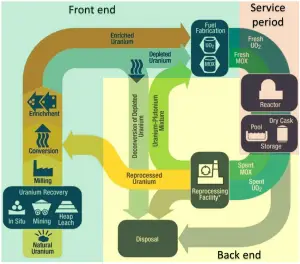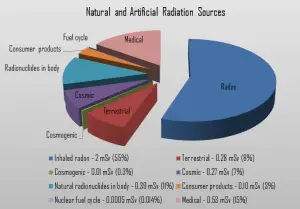
- The front end of the nuclear fuel cycle. The front end of the nuclear fuel cycle starts with the mining of uranium in the mines and ends with the delivery of the enriched uranium to the nuclear fuel assembly producer. Therefore, the front end of the fuel cycle consists of:
- Uranium mining, milling and mill tailings,
- Conversion
- Fuel enrichment
- Fabrication of fuel assemblies
- Service Period. The service period includes transport of fuel assemblies within a power plant, in-core fuel management, fuel utilization, and storage in the spent fuel pool.
- The back end of the nuclear fuel cycle. The back end of the nuclear fuel cycle involves managing the spent fuel after irradiation. Therefore, the back end of the fuel cycle consists of:
- spent interim fuel storage
- fuel reprocessing,
- final disposal of radioactive waste or spent fuel.
Types of Nuclear Fuel Cycles
As was written, the back end of the nuclear fuel cycle involves managing the spent fuel after irradiation. Therefore, the back end of the fuel cycle consists of:
- spent interim fuel storage
- fuel reprocessing,
- final disposal of radioactive waste or spent fuel.
There are three main types of nuclear fuel cycle:
- Once-through fuel cycle. An open fuel cycle is not a real cycle, and this strategy assumes that the fuel is used once and sent to long-term storage without further reprocessing. If spent fuel is not reprocessed, the fuel cycle is referred to as an open fuel cycle or a once-through fuel cycle, as the uranium components go through the reactor once. The once-through cycle comprises two main back-end stages:
- interim storage
- final disposal.
- Twice-through fuel cycle. The twice-through cycle strategy assumes that the spent nuclear fuel will be reprocessed to extract the uranium and plutonium, which can be recycled as fresh nuclear fuel for use in a nuclear reactor adapted to this type of fuel.
- Closed fuel cycle. The closed fuel cycle is an advanced fuel cycle whose purpose is to achieve nuclear power sustainability by further reducing the final waste’s radiotoxicity and improving resource utilization while maintaining its economic viability. There are currently different types of advanced fuel cycles under research, but most of them are based on the use of:
- Advanced Nuclear Reactors
- Fuel Reprocessing
These fuel strategies are based on specific processes in the entire fuel cycle (the back end, the front end, and the service period). All these scenarios are theoretical, and the practical solution will be, in any case, a combination of these options. In all cases, the fuel assemblies are first after irradiation, stored in spent fuel pools at the reactor site for an initial cooling period. Over time, as the spent fuel is stored in the pool, it becomes cooler as the radioactivity decays away. After several years (> 5 years), decay heat decreases under specified limits so that spent fuel may be reprocessed or interim storage. It must be added that any strategy for managing spent nuclear fuel will be built around combinations of many options, and all strategies must ultimately include permanent geological disposal.
The choices of nuclear fuel cycle (open, closed, or partially closed through limited spent fuel recycling) depend upon the technologies we develop and societal weighting of goals (safety, economics, waste management, and nonproliferation). Once choices are made, they will have major and long-term impacts on nuclear power development. Today we do not have sufficient knowledge to make informed choices for the best cycles and associated technologies.
See more: The Future of the Nuclear Fuel Cycle. An interdisciplinary MIT study. MIT, 2011. ISBN 978-0-9828008-4-3.
Neutron Flux – Uranium vs MOX Fuel
Note that there is a difference between neutron fluxes in the uranium fueled core and the MOX fueled core. In the first example, the average neutron flux in a uranium-loaded reactor core was calculated to be 3.11 x 1013 neutrons.cm-2.s-1. Compared with this value, the average neutron flux in a 100% MOX fueled core is about 2.6 times lower (1.2 x 1013 neutrons.cm-2.s-1), while the reaction rate remains almost the same. This fact is important in the reactor core design and the design of reactivity control. It is primarily caused by:
- higher fission cross-section of 239Pu. The fission cross-section is about 750 barns compared to 585 barns for 235U.
- higher energy release per one fission event. A MOX core does not require such neutron flux as a uranium-fueled core to generate the same amount of energy.
- larger fissile loading. The main reason is the larger fissile loading. MOX fuels have a relatively high buildup of 240Pu and 242Pu. Due to the relatively lower fission-to-capture ratio, there is a higher accumulation of these isotopes, parasitic absorbers, resulting in a reactivity penalty. Generally, the average regeneration factor η is lower for 239Pu fuel than for 235U fuel. Therefore the MOX fuel requires a larger fissile loading to achieve the same initial excess of reactivity at the beginning of the fuel cycle.
The relatively lower average neutron flux in MOX cores has the following consequences on reactor core design:
- Because of the lower neutron flux and the larger thermal absorption cross section for 239Pu, reactivity worth of control rods, chemical shim (PWRs), and burnable absorbers is less with MOX fuel.
- The high fission cross-section of 239Pu and the lower neutron flux lead to greater power peaking in fuel rods located near water gaps or when MOX fuel is loaded with uranium fuel together.
Radiation Exposures from Nuclear Fuel Cycle
 Radiation is all around us. In, around, and above the world we live in. It is a natural energy force that surrounds us, and it is a part of our natural world that has been here since the birth of our planet. From the beginning of time, all living creatures have been, and are still being, exposed to ionizing radiation. Ionizing radiation is generated through nuclear reactions, nuclear decay, very high temperature, or via acceleration of charged particles in electromagnetic fields.
Radiation is all around us. In, around, and above the world we live in. It is a natural energy force that surrounds us, and it is a part of our natural world that has been here since the birth of our planet. From the beginning of time, all living creatures have been, and are still being, exposed to ionizing radiation. Ionizing radiation is generated through nuclear reactions, nuclear decay, very high temperature, or via acceleration of charged particles in electromagnetic fields.
The nuclear fuel cycle is a process chain consisting of various stages. In general, the nuclear fuel cycle consists of steps in the front end (the preparation of the fuel), steps in the service period (fuel burnup), and steps in the back end (reprocessing or disposal of spent nuclear fuel). Radiation exposures from the nuclear fuel cycle are, according to UNSCEAR, evaluated from the entire life cycle of nuclear fuel, and this includes:
-
-
- uranium mining, milling and mill tailings,
- fabrication of fuel assemblies
- power plant operation (except accidents),
- spent fuel storage or reprocessing,
- disposal of radioactive waste,
- decommissioning activities.
-
The collective dose, which results from the nuclear fuel cycle, is:
-
-
- 130 man Sv for nuclear fuel cycle,
-
Almost half of the contribution to public exposure from the nuclear fuel cycle comes from discharges of natural radionuclides during uranium mining and milling activities.
The normalized collective dose (per gigawatt and year) is:
-
-
- 0.43 man Sv/GW.a (man sievert per gigawatt year) for nuclear fuel cycle
-
Special Reference: Sources and effects of ionizing radiation, UNSCEAR 2016 – Annex B. New York, 2017. ISBN: 978-92-1-142316-7.
In the following points, we try to express ranges of radiation exposure from electricity generation and doses, which can be obtained from various sources.
-
-
- 05 µSv – Sleeping next to someone
- 09 µSv – Living within 30 miles of a nuclear power plant for a year
- 1 µSv – Eating one banana
- 3 µSv – Living within 50 miles of a coal power plant for a year
- 10 µSv – Average daily dose received from natural background
-
The above doses are related to public exposure. If we consider occupational exposure regarding uranium mining, power plant workers, etc., the collective dose is higher, especially for uranium miners. The miners are surrounded by rocks and sloshing through groundwater exuding radon.
Note that the collective effective dose is often used to estimate the total health effects, but according to the ICRP, this should be avoided.